Hiking the Himalayas

Foothills of the Himalaya
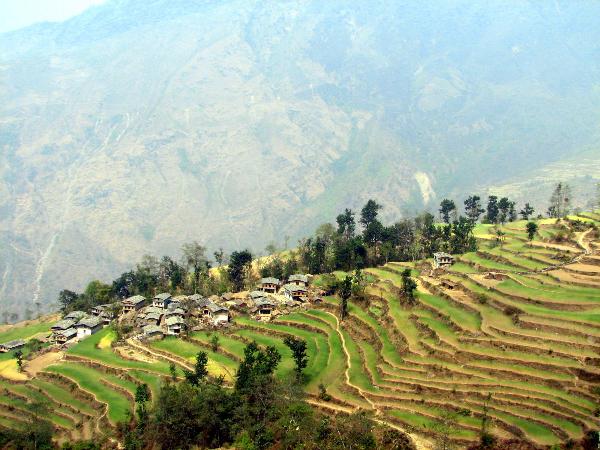
For centuries the Himalaya have served as a geographical transition zone between different ecosystems and different ethnic groups of people situated between the lowlands of the Indo-Gangetic plains and the high Tibetan plateau of China. Trade routes between these two regions have persisted for centuries and continue to link people and ideas here today. Trekking through these ancient trade routes is one of the best ways to truly experience the enormous geographic, ecological and cultural diversity of the Himalayan region.
This journey begins North of Kathmandu in Nepal's temperate "hill" region. The hill or Pahad zone of Nepal abuts the mountains between 2,625 to 13,123 feet (800 and 4,000 meters) in altitude ascending from subtropical climates below 3,937 feet (1,200 m) to alpine climates above 11,811 feet (3,600 m).
Only in a country as mountainous as Nepal could elevations this high be called "hills"! Most people reside in these lush valleys making use of the temperate climate to farm crops. In places such as this Garung village, people farm wheat and millet on ladder- like terraces ascending high up the slopes.
Mountain peoples

For the mountainous people living here, the Himalayas continue to be the major influence on their lives. Acting as a natural and political barrier for centuries, the Himalayas have isolated a number of communities, cultures and customs over time. Today the Nepali people are a complex mix of ethnic and cultural groups.
Taking a break from herding buffalo on the mountain slopes, these Garung children seldom see foreigners and came to investigate our appearance. Today, groups such as the Garung, Newari, Tamang, Sherpa and many others throughout the Himalaya continue to preserve distinct cultural identities and traditional livelihoods much as their ancestors did. Even so, with the spread of new forms of transportation, communications and technology, traditional knowledge and livelihoods are slowly being eroded.
Hill farming

Trekking into the Himalaya, you may be surprised to see entire mountainsides terraced in snaking contours of various crops like wheat and millet. In the Himalaya, as in other mountainous regions of the world, agricultural terracing is used as an ancient and ingenious way to slow or prevent the rapid run-off of irrigation water. Terracing helps to both minimize damaging erosion and slow down the speed of water run-off so that it may be sucked up by the soil and nurture crops.
Traditional farming practices adapted to mountain cultures and livelihoods, such as terracing, continue to be used by people throughout the Himalaya. Scenes like this one are a common site hiking through the mountains of rural Nepal, seemingly having changed little through the ages.
The snow line

Climbing steadily up the Himalayan hillsides, eventually you will reach the snow line. Here, evergreen broadleaf trees give way to subalpine forests of conifers between about 9,800 and 13,000 feet (3,000 and 4,000 m). Species like junipers and rhododendrons dominate these forests while bamboo, ferns and mosses blanket the forest floor. Since the snow line constantly advances and retreats with the seasons, different plants invariably begin to bloom as the snow melts off the mountainsides to take advantage of spring.
You may know of rhododendrons as ornamental shrubs decorating gardens at home, but the Himalayas are where rhododendrons trace their origin and reach their most showy expression. Here these shrubs can grow to tree-like proportions represented by over 30 species in kaleidoscopic colors of reds, whites and purples.
Many animals live in these forests as well. With some luck you may even see such creatures as the Himalayan Monal (Lophophorus impejanus), the national bird of Nepal, or the elusive red panda (Ailurus fulgens), both of which call the forests here home.
Above the snow line
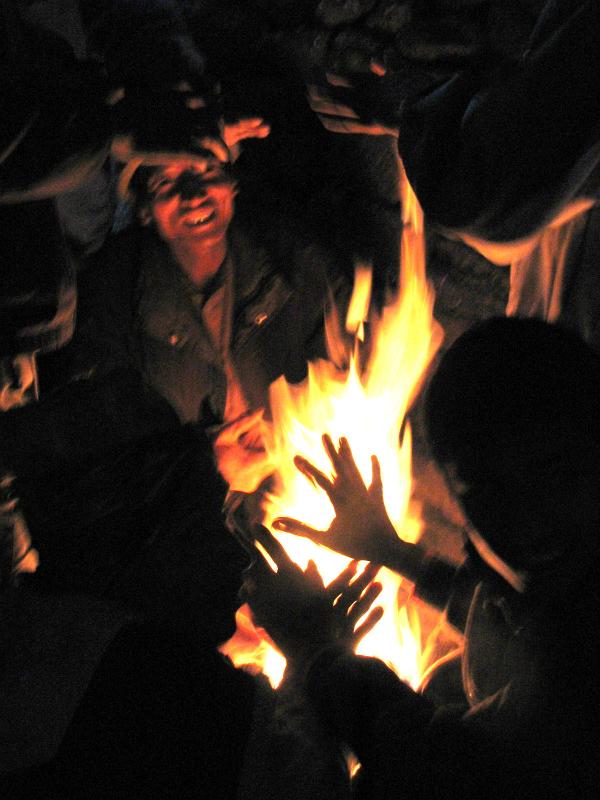
Above the snow line trees may gradually give way to dense alpine shrubs and high meadows of wildflowers. During the summer month's, local people bring animals up to these high summer pastures to graze, often constructing temporary shepherd's huts to watch their animals and later abandoning the huts with the coming of winter.
Not yet being summer, we were lucky to have found this nearby shepherd's hut in which to build a fire and take shelter from a sudden late winter blizzard. Weather in the Himalayas is always temperamental and sometimes deadly.
These massive mountains have a profound effect on the climate of all Asia. By preventing dry, frigid Arctic winds from blowing south into the Indian sub-continent, the Himalayas keep South Asia much warmer than it otherwise would be. Likewise the Himalaya form a massive barrier to keep the monsoon winds from traveling northwards, causing heavy rainfall to dump on the southern slopes while creating a vast rain shadow on the northern slopes extending into the high and dry Tibetan plateau.
Fox tracks in fresh snow

The Great Himalaya range is the highest mountain range on Earth . Within Nepal or near its border with Tibet, seven of the world's eight-thousand-meter peaks reside, including 8,848-meter (29,029-ft) Mount Everest, the highest peak on Earth. The enormous scale of these mountains have long amazed and humbled visitors to them.
The name Himalaya comes from an ancient Sanskrit word literally meaning, "the abode of the snows." This name is fitting as the highest peaks of the Himalaya remain covered in perpetual snows year round. Up here only very hardy and specialized plants are able to survive while animal life becomes even rarer.
Some animals like the Blue Sheep (Pseudois nayur) or the snow leopard (Uncia uncia) have managed to evolve and thrive in these harsh conditions. Most of these animals though are so elusive that the most you might ever see may be their calling cards, like the tracks from this Tibetan Fox (Vulpes ferrilata) disappearing over the snowy ridge tops.
The holy lake of Bharaiv Kunda
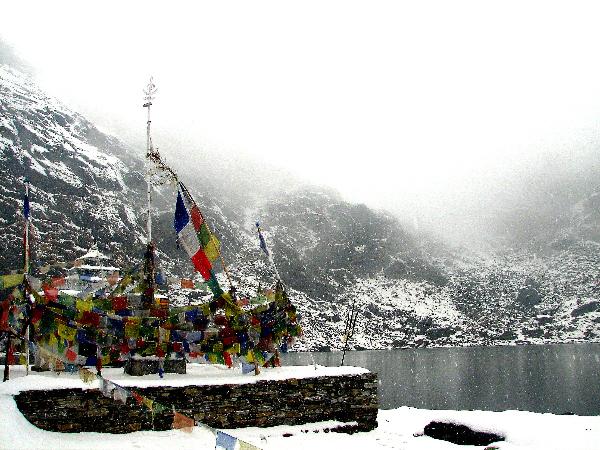
Visitors and locals traverse the Himalaya for many reasons physical, spiritual, cultural and ultimately personal. For many, trekking into the high snows of the tallest, arguably most formidable, mountain range on Earth is a challenge of endurance and a test of faith. Pilgrimages to holy sites, such as Mount Kalaish in Tibet, are an ancient rite of devotees for many Himalayan faiths.
This shrine at the lake of Bhairav Kunda, named after the destructive aspect of Lord Shiva, is a sacred pilgrimage site for Shamans. In the summer many Hindu and Buddhist pilgrims visit this high altitude lake near the Tibetan border to cleanse their souls and wash away their sins in its holy waters. Many such places throughout the Himalayas contain great spiritual significance for a variety of peoples and faiths.
Get the world’s most fascinating discoveries delivered straight to your inbox.
Sherpa gompa
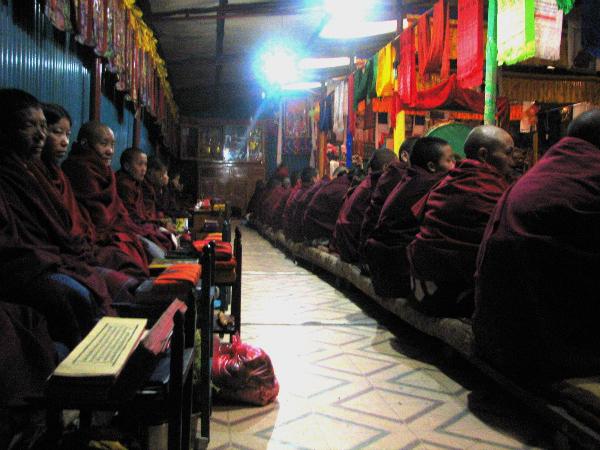
The Sherpa people hail from the Khumbu region of Eastern Nepal near Mount Everest, where they are famous as great mountaineers. They migrated to Nepal from Tibet about 300 years ago and belong to one of the oldest sects of Tibetan Buddhism in the Himalayas.
Sherpa religion is centered around local monasteries or gompas. Dozens of these monasteries are scattered over Sherpa communities in the high mountains of Nepal and Tibet. Gompas are made up of communities of lamas (Buddhist spiritual leaders), monks and nuns who live ascetic lives of celibacy and isolation in search of truth and enlightenment.
The gompa, like this one I was invited into on a festival day, is cared for communally by the local village as a tradition and institution central to the Buddhist religion. Only during these annual festival days and on special occasions do monks and nuns have contact with the outside world.
Mountain gods and demons
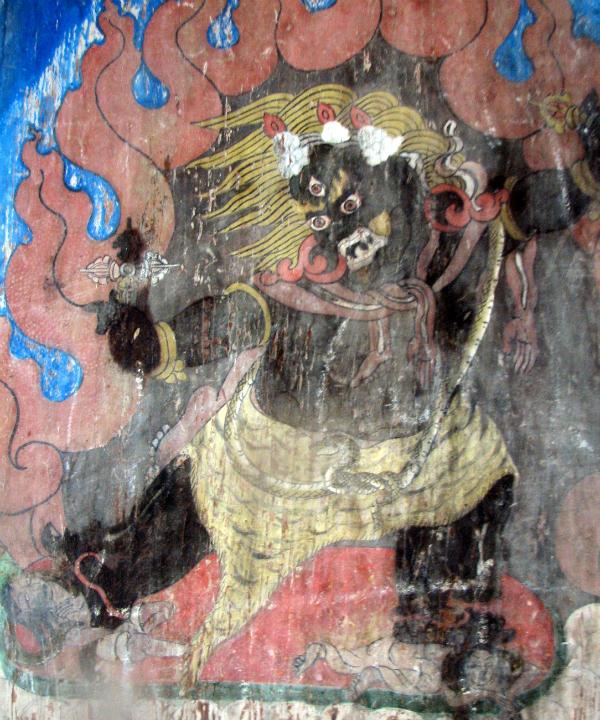
The Sherpa form of Buddhism incorporates mysticism with shamanistic practices and local deities taken from pre-Buddhist religions. In addition to belief in the Buddha and the other great Buddhist divinities, Sherpas also believe that many gods and demons inhabit the mountains, caves and forests. Many of the great Himalayan peaks, such as Mount Everest, known as Chomolungma, are worshipped as the protective deities for numerous gods in Sherpa religion.
Religious works of art, like this wrathful mountain God adorning a local gompa, help weave the worship of these gods into religious belief and ritual in Buddhist cosmology.
Roof of the world
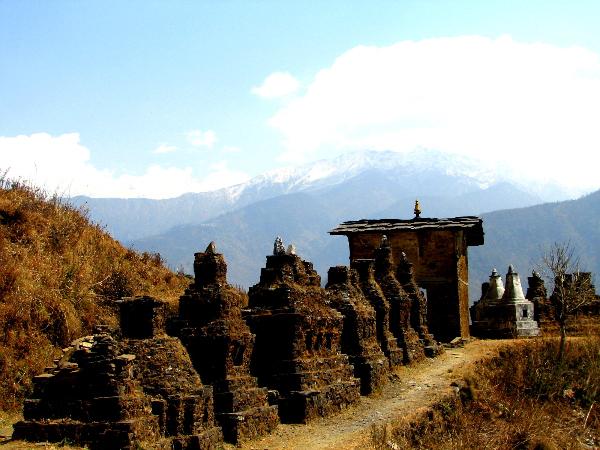
The Tibetan plateau has been called, "the roof of the world." This vast high altitude mountainous plain seems to scrape the very clouds. It is no wonder that in Tibet the Himalaya is worshipped as the mother of the Earth, symbolic of the greatest inspiration and perseverance.
Having come from the subtropical foothills and climbed to the snow-capped peaks of the Himalaya is a journey across ecosystems, geographies, cultures and histories. Now, walking along the border with Tibet, a medieval watchtower full of crumbling motifs of the Buddha and airy views over the world is a good place to rest weary legs.
Sitting eye level with the clouds looking north, the Jugal Himal range crests over 19,700 feet (6,000 m) into Tibet. This being just one small section of this greatest of mountain ranges, the Great Himalaya, it is impossible not to feel small, humbled and deeply impressed.


